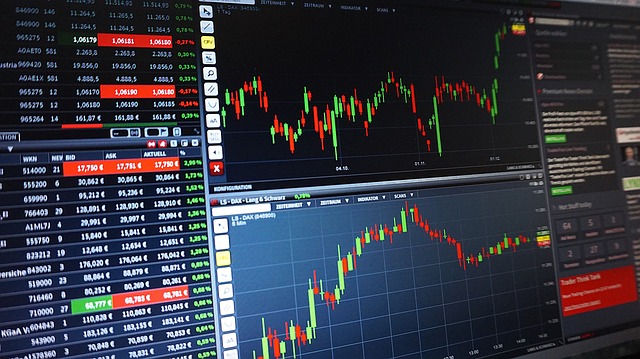The Rise of Trading Bots in Cryptocurrency: Revolutionizing the Trading Landscape
Author: Jameson Richman Expert
Published On: 2024-07-30
Prepared by Jameson Richman and our team of experts with over a decade of experience in cryptocurrency and digital asset analysis. Learn more about us.
The cryptocurrency market, known for its volatility and 24/7 operational hours, has created a fertile ground for trading bots. These automated systems are designed to facilitate trading activities, allowing investors to optimize their strategies and secure potential profits with minimal human intervention. In this article, we will explore various aspects of trading bots in the crypto market, their functionalities, the technology behind them, and their impact on traders and the market as a whole.

Understanding Trading Bots: What Are They?
Trading bots, simply put, are software programs that use algorithms to execute trades based on predefined criteria. In the context of cryptocurrency, these bots monitor market conditions in real-time, analyzing trends, price movements, and other key data points to make informed trading decisions.
The History of Trading Bots in Crypto
Although the concept of trading bots is not new, their application in cryptocurrency is relatively recent. The growth of the crypto market has seen an influx of retail and institutional traders, many of whom are turning to automation to improve trading efficiency. The genesis of these bots was largely due to the need for speed in executing trades, which can be vital in a market where prices can change within seconds.
How Trading Bots Work
Trading bots operate on various algorithms and strategies, and the choice between the two can influence their performance. They work by integrating with cryptocurrency exchanges through APIs (Application Programming Interfaces) and can be programmed for numerous functionalities.
Key Functions of Trading Bots
Types of Trading Bots
In the world of cryptocurrency, not all trading bots are created equal. They can generally be categorized into a few distinct types based on their functionality and trading strategy.
1. Arbitrage Bots
Arbitrage bots exploit price discrepancies across different exchanges. For example, if Bitcoin is priced at $40,000 on Exchange A and $40,500 on Exchange B, an arbitrage bot will buy low on one exchange and sell high on the other, pocketing the difference. This method can be highly profitable but requires quick execution and minimal transaction fees.
2. Market-Making Bots
Market-making bots provide liquidity in the market by placing buy and sell orders simultaneously. Their goal is to capitalize on the spread—the difference between buying and selling prices. Market-making is crucial for ensuring that there is enough liquidity in a trading pair, allowing for smoother transactions.
3. Trend-Following Bots
As the name suggests, trend-following bots are designed to identify and capitalize on market trends. They use technical indicators like moving averages or the Relative Strength Index (RSI) to make trading decisions. For investors favoring a more systematic approach to trading, trend-following bots can be incredibly useful.
Advantages of Using Trading Bots
Utilizing trading bots offers several advantages that traditional trading methods may struggle to provide.
1. 24/7 Market Monitoring
Cryptocurrencies trade around the clock, making it challenging for an individual trader to monitor all market activities continuously. Trading bots operate day and night, executing trades based on the trader's predetermined strategies without the need for constant supervision.
2. Eliminating Emotional Trading
One of the key benefits of using a trading bot is its ability to eliminate emotional decision-making. Trading can be stressful, especially when markets are volatile. Bots execute trades based on data and analytics rather than emotions, potentially leading to more rational and strategic trading decisions.
3. Speed and Efficiency
Bots can process large volumes of data and make trading decisions within milliseconds—far quicker than a human trader. In a market where prices can fluctuate rapidly, this speed can make a significant difference.
4. Backtesting and Strategy Refinement
Many trading bots come with backtesting capabilities, allowing traders to test their strategies against historical data before deploying them in real-time. This can help traders understand the potential effectiveness of a strategy and refine it accordingly.

Risks and Challenges of Using Trading Bots
While trading bots offer numerous benefits, several risks and challenges come with their use.
1. Technical Failures
Like any software, trading bots can experience technical failures or bugs. A technical issue during a critical trading period could lead to significant losses, and traders must stay vigilant even with automated trading.
2. Market Manipulation
Not all trading bots operate ethically. Some might attempt to manipulate markets by executing strategies designed to create false signals. Traders must choose trustworthy bots that comply with reputable trading practices.
3. Over-Optimization
Traders might fall into the trap of over-optimizing their bot’s strategy based on past performance, leading to a phenomenon known as “curve fitting.” A strategy that performs well in historical simulations may not work in real-time trading due to changing market conditions.
Choosing the Right Trading Bot
With the plethora of trading bots available, selecting the best one for your needs can seem daunting. Here are several factors to consider:
1. Reputation and Reviews
Before committing to a trading bot, it’s essential to research and read reviews from other users. An established bot with a strong reputation often indicates reliability and an effective system.
2. Fee Structure
Many trading bots operate on a fee structure, whether through subscription fees or taking a percentage of profits. Evaluate these costs carefully to understand their impact on your overall profitability.
3. Features and Customization
Different bots come with various features. Some may offer extensive customization options, while others may provide limited functionalities. Identify what features matter most for your trading strategy.
4. Customer Support
Access to responsive customer support is crucial. In the fast-paced world of trading, having a support system in place can be invaluable when issues arise.
Conclusion: The Future of Cryptocurrency Trading Bots
As the cryptocurrency market continues to evolve, trading bots will likely become a cornerstone of trading strategies. While they offer several advantages, such as speed, efficiency, and emotional detachment, traders must remain aware of the associated risks. In my opinion, the successful use of trading bots hinges on continuous learning and adaptability; market conditions can change rapidly, and a one-size-fits-all approach may not yield the best results. Ultimately, the future will reflect a balance between automation and strategic human oversight—creating a trading environment that leverages the strengths of both worlds.